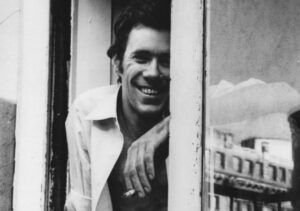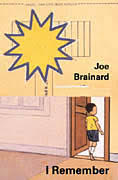This isn’t the first time I’ve mentioned Eugene. I remember exactly where he sat, second row back, in the seventh-grade class as PS 187. I remember his laser-beam smirk as I read aloud from Joe Brainard’s book, and before I could send the students into their own lists of “I remembers,” Eugene raised his hand: “Why are we doing this? It seems pointless.” I said something about the importance of specific, sensory detail in our writing, but my reply didn’t erase the look on Eugene’s face. I looked down at the book for examples: “I remember the chocolate Easter bunny problem of where to start… I remember rocks you pick up outside that, once inside, you wonder why.” As much as I loved these lines, maybe Eugene had a point?

In that moment, I was unprepared to justify the lesson. I had led the same “I Remember” exercise countless times, and it always worked wonders. Students listened to excerpts from Brainard’s book with dreamy attention. They often laughed openly in recognition and amusement. People with difficulty writing found a flow while composing their own lists, and they read their memories aloud in speech rhythms that felt authentic, spontaneous, and poetic. Students listened attentively and respectfully to each other’s words, and the classroom grew perceptibly warmer for the experience. Many of you know what I’m talking about. We call them “I remembers,” and they work.
Later, as I obsessed over Eugene’s remarks, a few poets chimed in. William Blake, in “Jerusalem,” exhorts: “Labor well to the Minute Particulars: attend to the Little Ones.” In “Crossing Brooklyn Ferry,” Walt Whitman sings at great length about “the glories strung like beads upon my smallest sights and hearings.” And Frank O’Hara, who makes several sparkling cameos in I Remember, asserts: “Oh! kangaroos, sequins, chocolate sodas! You really are beautiful!” I felt encouraged by this choir of kindred spirits, but I didn’t feel any closer to convincing a skeptical seventh-grader.
The more I thought about Brainard’s book, the more I realized that its “pointlessness” is part of its greatness. Without explanation or apology, Brainard refuses to be linear. He displays personal detail for the sake of personal detail, liberated from the imperatives to “reveal character” or “advance narrative.” No straightforward “plot development” or “climax” or “epiphany”; instead, he swerves at his leisure, allowing memories, big and small, to exist in a list with their color, wit, and music.
I remember that the red Crayola was always the
first to go.I remember the olive green lining of my mother’s
olive green “leather” jewelry box, with fold-out
trays. When alone in the house, I loved going
through it, examining each piece carefully, trying
to pick out the favorites. And sometimes, trying on
something, but mostly, I just liked to look.I remember, after school, a period of three or four
minutes of lots of locker doors being slammed. And
long corridor echoes.
His seemingly simple sentences deliver various pleasures. They roll out, unrushed and unpretentious, as our attention flickers with curiosity, identification, and surprise. In sequence, they demonstrate the unexpected juxtapositions that occur when we allow ourselves to free associate:
I remember how good wet dreams were.
I remember a rollercoaster that went out over a
lake.

And reading I Remember, we experience Brainard’s marvelous candor. Anyone who’s read excerpts from I Remember in front of a class knows that you can’t flip to just any page and read aloud. But if you censor too severely, you will miss out on one of Brainard’s gifts: the implicit permission issued to the reader-writer to “remember” without inhibition. As artists and writers, we know there is a point to all of this. But as teachers, we may be pressed to explain it. The “I Remember” exercise can serve clear and pointed pedagogical purposes: it can be a lead-in to a unit on the personal essay, or students can select one of their lines and expand it into a descriptive poem or fictional story. It can be used as a “community-building” exercise at the beginning of a class or workshop, or it can be adapted into a culminating “free write” that reflects on a specific educational experience. Still, I think the particular magic of I Remember is the permission it issues to ditch the compass and wander, to revel in the remembered details of our lives as they emerge in their own mysterious order, to sidestep the tyranny of the timeline and open ourselves to other possibilities, to affirm the trivial along with the significant, and to perceive that this hierarchy may be flimsier than we imagined. As any snooping child knows, the plastic beads in a box of jewelry are no less glorious.
This article was originally published in the Winter 2012-2013 issue of Teachers & Writers Magazine.
Matthew Burgess is an Associate Professor at Brooklyn College. He is the author of eight children's books, most recently The Red Tin Box (Chronicle) and Sylvester’s Letter (ELB). Matthew has edited an anthology of visual art and writing titled Dream Closet: Meditations on Childhood Space (Secretary Press), as well as a collection of essays titled Spellbound: The Art of Teaching Poetry (T&W). More books are forthcoming, including: As Edward Imagined: A Story of Edward Gorey (Knopf, 2024), Words With Wings & Magic Things (Tundra, 2025), and Fireworks (Harper Collins, 2024). A poet-in-residence in New York City public schools since 2001, Matthew serves as a contributing editor of Teachers & Writers Magazine.




One response to ““Glories Strung Like Beads””
[…] responding to the writing prompt “I Remember…” with a brief cherished memo (read more on the inspiration for this prompt). […]